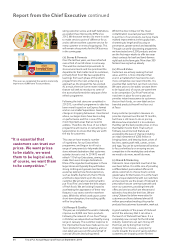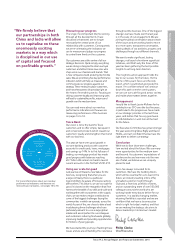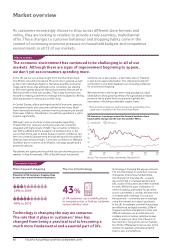Tesco 2014 Annual Report Download - page 17
Download and view the complete annual report
Please find page 17 of the 2014 Tesco annual report below. You can navigate through the pages in the report by either clicking on the pages listed below, or by using the keyword search tool below to find specific information within the annual report.
We are spending significantly less on new space. In the UK we have
already reduced our investment from 2.5 million square feet at
peak. In the coming year, we will open just 0.9 million square feet
of net new space. This includes almost 200,000 square feet of
franchise space in One Stop. In Europe, we will open just 275,000
square feet of net new space and focus more of our investment
on high-returning opportunities in Asia.
Property
The market value of our property across the Group currently exceeds
£34 billion, with the most significant driver of the reduction since last
year being the impact of foreign exchange rates.
Historically, by acquiring and developing high-quality stores we
grew the value of our property significantly and unrealised property
profits built up. We have had an active programme of releasing
value from our property portfolio over many years. We continue
to look at our property portfolio in order to maximise value in
the most appropriate way for the business as a whole. Excluding
one-off items, profits arising from property-related items declined
to £180 million this year, in line with the reduction of our sale and
leaseback programme outlined last year. This year we have focused
on South Korea and we completed a sale-and-leaseback in January
comprising four Homeplus stores and accompanying mall space.
Pension
Our pension is an extremely valuable benefit for colleagues and
one we are proud to offer. IFRS accounting gives a marked-to-
market measure of our pension liabilities, based on market
conditions which of course can be volatile in the short term,
whereas the liabilities are clearly long-term in nature.
Our after-tax IAS 19 pension deficit this year has risen to
£2.6 billion, mainly due to a reduction in real corporate bond
yields with a subsequent fall in the discount rate used to measure
our liabilities. A triennial actuarial valuation will be carried out to
measure our liabilities as at 31 March 2014 and this will be
completed in 2015.
Return on capital employed
When we complete our partnership with CRE, our Group return
on capital employed will reflect our share of the partnership’s
assets and profits or losses. Given that we expect to complete
the partnership in the first half of 2014/15 we have given a
pro-forma Group ROCE including our Chinese business. On this
basis, our Group ROCE was 12.1%, which is a comparable figure
to the 12.7% we reported last year. Excluding our Chinese
business based on its current accounting treatment as a
discontinued operation, our Group ROCE would be 13.6%.
The UK continues to earn the highest returns in the Group and
our businesses in Asia are high-returning. Europe’s returns remain
below cost of capital. We will continue to limit capital expenditure
in this region and focus our efforts on improving our offer for
customers in existing stores.
Tesco Bank
Tesco Bank generated £194 million trading profit this year.
Excluding income from the legacy insurance distribution
agreement which terminated in 2012/13 and fair value releases
resulting from the unwind of an acquisition accounting
adjustment, it grew by 19%.
We have seen good growth in our core banking products with
customer accounts for credit cards, loans, mortgages and savings
up 14%. After the first full year of trading, mortgage balances have
grown to £0.7 billion and we have helped over 4,000 customers to
own their homes. Those customers have borrowed an average of
just under £170,000 with a loan-to-value ratio of just over 50%.
Reflecting the challenging market conditions, with increased
competition driving a marked reduction in premiums across the
industry, the profit contribution of our Insurance business was
down (17)% this year (excluding legacy income).
Tesco Bank results
£m % growth
Tesco Bank revenue (exc. VAT, exc. impact of IFRIC 13) £1,003m (1.8)%
Tesco Bank trading profit £194m 1.6%
Tesco Bank trading margin (trading profit/revenue) 19.34% 63bp
The Bank will soon complete its suite of products with a current
account launching in the first half. We expect the growth in
underlying trading profit in 2014/15 to be broadly offset by
the investment in current accounts.
Within one-off items, the Bank has made a further increase to
the provision for payment protection insurance of £(20) million
and a provision of £(43) million for other customer redress.
The Bank’s balance sheet remains strong with good levels of
liquidity. Although customer deposits remain the primary source
of funding, the funding base was diversified during the year with
a credit card securitisation and participation in the Funding for
Lending scheme.
Group balance sheet and cash flow
Net debt has remained stable year-on-year at £6.6 billion.
In the context of declining underlying profit, lower property
proceeds and a maintained dividend, this demonstrates our
discipline and focus on cash.
Two metrics that we use to guide our internal decisions and which
support our discipline to maintain a strong investment grade credit
rating are net indebtedness and fixed charge cover. This year net
indebtedness rose slightly to 3.16 times and fixed charge cover
remained stable at 3.4 times.
This year we spent £2.7 billion of capex, or £3.0 billion including
China. We are reducing our capital expenditure to no more than
£2.5 billion for at least the next three years. A greater proportion
of this reduced overall spend is devoted to our existing stores.
We are accelerating our refresh programme in the UK and we are
also maintaining our level of spend on technology to ensure that
we have the necessary capabilities for a truly multichannel offer.
14 Tesco PLC Annual Report and Financial Statements 2014
Financial review continued
























